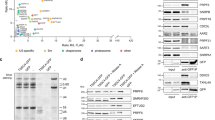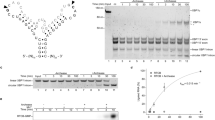Abstract
The structure of the U-box in the essential Saccharomyces cerevisiae pre-mRNA splicing factor Prp19p has been determined by NMR. The conserved zinc-binding sites supporting the cross-brace arrangement in RING-finger domains are replaced by hydrogen-bonding networks in the U-box. These hydrogen-bonding networks are necessary for the structural stabilization and activity of the U-box. A conservative Val→Ile point mutation in the Prp19p U-box domain leads to pre-mRNA splicing defects in vivo. NMR analysis of this mutant shows that the substitution disrupts structural integrity of the U-box domain. Furthermore, comparison of the Prp19p U-box domain with known RING–E2 complex structures demonstrates that both U-box and RING-fingers contain a conserved interaction surface. Mutagenesis of residues at this interface, while not perturbing the structure of the U-box, abrogates Prp19p function in vivo. These comparative structural and functional analyses imply that the U-box and its associated ubiquitin ligase activity are critical for Prp19p function in vivo.
This is a preview of subscription content, access via your institution
Access options
Subscribe to this journal
Receive 12 print issues and online access
$189.00 per year
only $15.75 per issue
Buy this article
- Purchase on Springer Link
- Instant access to full article PDF
Prices may be subject to local taxes which are calculated during checkout




Similar content being viewed by others
References
Pickart, C.M. Mechanisms underlying ubiquitination. Annu. Rev. Biochem. 70, 503–533 (2001).
Cyr, D.M., Hohfeld, J. & Patterson, C. Protein quality control: U-box-containing E3 ubiquitin ligases join the fold. Trends Biochem. Sci. 27, 368–375 (2002).
Patterson, C. A new gun in town: the U box is a ubiquitin ligase domain. Sci. STKE [online] <http://stke.sciencemag.org/cgi/content/full/ OC_sigtraus;2002/116/pe4> (2002).
Koegl, M. et al. A novel ubiquitination factor, E4, is involved in multiubiquitin chain assembly. Cell 96, 635–644 (1999).
Aravind, L. & Koonin, E.V. The U box is a modified RING finger — a common domain in ubiquitination. Curr. Biol. 10, R132–R134 (2000).
Tarn, W.Y., Lee, K.R. & Cheng, S.C. Yeast precursor mRNA processing protein PRP19 associates with the spliceosome concomitant with or just after dissociation of U4 small nuclear RNA. Proc. Natl. Acad. Sci. USA 90, 10821–10825 (1993).
McDonald, W.H., Ohi, R., Smelkova, N., Frendewey, D. & Gould, K.L. Myb-related fission yeast Cdc5p is a component of a 40S snRNP-containing complex and is essential for pre-mRNA splicing. Mol. Cell. Biol. 19, 5352–5362 (1999).
Chen, H.R. et al. Snt309p, a component of the Prp19p-associated complex that interacts with Prp19p and associates with the spliceosome simultaneously with or immediately after dissociation of U4 in the same manner as Prp19p. Mol. Cell. Biol. 18, 2196–2204 (1998).
Ohi, M.D. & Gould, K.L. Characterization of interactions among the Cef1p-Prp19p-associated splicing complex. RNA 8, 798–815 (2002).
Cavanagh, J., Fairbrother, W.J., Palmer, A.G. & Skelton, N.J. Protein NMR Spectroscopy: Principles and Practice (Academic Press, San Diego; 1996).
Gervais, V. et al. Solution structure of the N-terminal domain of the human TFIIH MAT1 subunit: new insights into the RING finger family. J. Biol. Chem. 276, 7457–7464 (2001).
Hanzawa, H. et al. The structure of the C4C4 ring finger of human NOT4 reveals features distinct from those of C3HC4 RING fingers. J. Biol. Chem. 276, 10185–10190 (2001).
Bellon, S.F., Rodgers, K.K., Schatz, D.G., Coleman, J.E. & Steitz, T.A. Crystal structure of the RAG1 dimerization domain reveals multiple zinc-binding motifs including a novel zinc binuclear cluster. Nat. Struct. Biol. 4, 586–591 (1997).
Zheng, N., Wang, P., Jeffrey, P.D. & Pavletich, N.P. Structure of a c-Cbl-UbcH7 complex: RING domain function in ubiquitin-protein ligases. Cell 102, 533–539 (2000).
Zheng, N. et al. Structure of the Cul1–Rbx1–Skp1–F boxSkp2 SCF ubiquitin ligase complex. Nature 416, 703–709 (2002).
Brzovic, P.S., Rajagopal, P., Hoyt, D.W., King, M.C. & Klevit, R.E. Structure of a BRCA1–BARD1 heterodimeric RING–RING complex. Nat. Struct. Biol. 8, 833–837 (2001).
Hatakeyama, S., Yada, M., Matsumoto, M., Ishida, N. & Nakayama, K.I. U box proteins as a new family of ubiquitin-protein ligases. J. Biol. Chem. 276, 33111–33120 (2001).
Huang, L. et al. Structure of an E6AP-UbcH7 complex: insights into ubiquitination by the E2-E3 enzyme cascade. Science 286, 1321–1326 (1999).
Pringa, E., Martinez-Noel, G., Muller, U. & Harbers, K. Interaction of the ring finger-related U-box motif of a nuclear dot protein with ubiquitin-conjugating enzymes. J. Biol. Chem. 276, 19617–19623 (2001).
Chen, H.R. et al. Snt309p, a component of the Prp19p-associated complex that interacts with Prp19p and associates with the spliceosome simultaneously with or immediately after dissociation of U4 in the same manner as Prp19p. Mol. Cell. Biol. 18, 2196–2204 (1998).
Vijayraghavan, U., Company, M. & Abelson, J. Isolation and characterization of pre-mRNA splicing mutants of Saccharomyces cerevisiae. Genes Dev. 3, 1206–1216 (1989).
Jiang, J. et al. CHIP is a U-box-dependent E3 ubiquitin ligase: identification of Hsc70 as a target for ubiquitylation. J. Biol. Chem. 276, 42938–42944 (2001).
Murata, S., Minami, Y., Minami, M., Chiba, T. & Tanaka, K. CHIP is a chaperone-dependent E3 ligase that ubiquitylates unfolded protein. EMBO Rep. 2, 1133–1138 (2001).
Meacham, G.C., Patterson, C., Zhang, W., Younger, J.M. & Cyr, D.M. The Hsc70 co-chaperone CHIP targets immature CFTR for proteasomal degradation. Nat. Cell. Biol. 3, 100–105 (2001).
Imai, Y. et al. CHIP is associated with Parkin, a gene responsible for familial Parkinson's disease, and enhances its ubiquitin ligase activity. Mol. Cell 10, 55–67 (2002).
Tarn, W.Y. et al. Functional association of essential splicing factor(s) with PRP19 in a protein complex. EMBO J. 13, 2421–2431 (1994).
Bartels, C., Xia, T., Billeter, M., Guntert, P. & Wuthrich, K. XEASY. J. Biomol. NMR 6, 1–10 (1995).
Cornilescu, G., Delaglio, F. & Bax, A. Protein backbone angle restraints from searching a database for chemical shift and sequence homology. J. Biomol. NMR 13, 289–302 (1999).
Guntert, P., Mumenthaler, C. & Wuthrich, K. Torsion angle dynamics for NMR structure calculation with the new program DYANA. J. Mol. Biol. 273, 283–298 (1997).
Pearlman, D.A. et al. AMBER 4.1 (San Francisco, CA.: University of California, San Francisco; 1995).
Maler, L., Potts, B.C. & Chazin, W.J. High resolution solution structure of apo calcyclin and structural variations in the S100 family of calcium-binding proteins. J. Biomol. NMR 13, 233–247 (1999).
Maler, L., Blankenship, J., Rance, M. & Chazin, W.J. Site-site communication in the EF-hand Ca2+-binding protein calbindin D9k. Nat. Struct. Biol. 7, 245–250 (2000).
Sastry, M. et al. The three-dimensional structure of Ca2+-bound calcyclin: implications for Ca2+-signal transduction by S100 proteins. Structure 6, 223–231 (1998).
Lackner, P., Koppensteiner, W.A., Sippl, M.J. & Domingues, F.S. ProSup: a refined tool for protein structure alignment. Protein Eng. 13, 745–752 (2000).
Koradi, R., Billeter, M. & Wuthrich, K. MOLMOL: a program for display and analysis of macromolecular structures. J. Mol. Graph. 14, 51–55 (1996).
Laskowski, R.A., Rullman, J.A., MacArthur, M.W., Kaptein, R. & Thornton, J.M. AQUA and PROCHECK-NMR: programs for checking the quality of protein structures solved by NMR. J. Biomol. NMR 8, 477–486 (1996).
Acknowledgements
We thank S. Hatakeyama and K.I. Nakayama from the Department of Molecular and Cellular Biology at Kyushu University for the kind gift of GST-Ubc3. We also gratefully acknowledge J.A. Smith for valuable technical assistance with structure calculations and molecular graphics. Work in our laboratories was supported by the National Institutes of Health in the form of operating grants to K.L.G. and W.J.C., training grant positions to M.D.O., C.W.V.K. and J.A.R., and core facility grants to the Vanderbilt Ingram Cancer Center and the Vanderbilt Center in Molecular Toxicology. K.L.G. is an Associate Investigator of the Howard Hughes Medical Institute.
Author information
Authors and Affiliations
Corresponding authors
Ethics declarations
Competing interests
The authors declare no competing financial interests.
Rights and permissions
About this article
Cite this article
Ohi, M., Vander Kooi, C., Rosenberg, J. et al. Structural insights into the U-box, a domain associated with multi-ubiquitination. Nat Struct Mol Biol 10, 250–255 (2003). https://doi.org/10.1038/nsb906
Received:
Accepted:
Published:
Issue Date:
DOI: https://doi.org/10.1038/nsb906
This article is cited by
-
Genome-wide analysis of the U-box E3 ligases gene family in potato (Solanum tuberosum L.) and overexpress StPUB25 enhance drought tolerance in transgenic Arabidopsis
BMC Genomics (2024)
-
Deep orange gene editing triggers temperature-sensitive lethal phenotypes in Ceratitis capitata
BMC Biotechnology (2024)
-
UBE2A and UBE2B are recruited by an atypical E3 ligase module in UBR4
Nature Structural & Molecular Biology (2024)
-
Genome-wide identification and expression analysis of U-box gene family in Juglans regia L.
Genetic Resources and Crop Evolution (2023)
-
Heat-induced RING/U-BOX E3 ligase, TaUHS, is a negative regulator by facilitating TaLSD degradation during the grain filling period in wheat
Plant Growth Regulation (2023)



